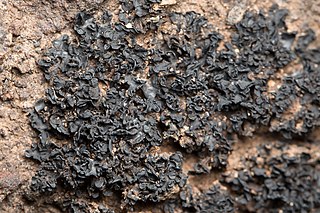
Lichinales is the sole order of ascomycete fungi in the class Lichinomycetes. It contains three families: Gloeoheppiaceae, Lichinaceae, and Peltulaceae. Most species are lichenized. Lichinales was proposed in 1986 by German lichenologists Aino Henssen and Burkhard Büdel. The class Lichinomycetes was created by Valérie Reeb, François Lutzoni and Claude Roux in 2004.

The Lichinaceae are a family of ascomycete fungi. Most species are lichenized with cyanobacteria, and have a distribution largely in temperate regions.
Anema is a genus of lichen within the family Lichinaceae. The genus contains at least 13 species.
Cryptothele is a genus of lichen within the family Lichinaceae. The genus contains eight species, two of which are found in North America.
Digitothyrea is a genus of fungi within the family Lichinaceae. The genus contains three species.
Edwardiella is a genus of fungi within the family Lichinaceae. This is a monotypic genus, containing the single species Edwardiella mirabilis. Aino Henssen named the genus after the Prince Edward Islands, the type locality of the type species.
Lemmopsis is a genus of fungi in the family Lichinaceae. The genus contains three species.

Lempholemma is a genus of lichen-forming fungi in the family Lichinaceae.
Leprocollema is a genus of fungi in the family Lichinaceae. It was circumscribed in 1890 by lichenologist Edvard August Vainio. The genus is monotypic, containing only the single species Leprocollema americanum.

Lichina is a genus of lichens in the family Lichinaceae. The genus contains seven species. These cyanolichens include maritime species such as L. pygmaea or L. confinis, in which the associated cyanobiont has been assigned to the genus Rivularia. Furthermore, evidence of a high specificity of each mycobiont towards particular cyanobiont lineages in both species has been detected.
Lichinodium is a genus of filamentous lichens. It is the only genus in the family Lichinodiaceae, itself the only member of the order Lichinodiales. Lichinodium has four species. Previously considered part of the class Lichinomycetes, molecular phylogenetic analysis revealed that Lichinodium represents a unique lineage in the Leotiomycetes—the first known group of lichen-forming fungi in this class.
Paulia is a genus of lichenized fungi within the family Lichinaceae. It contains five species.
Phylliscum is a genus of lichenized fungi in the family Lichinaceae. The genus contains two species.
Pseudopaulia is a genus of lichenized fungi within the family Lichinaceae. This is a monotypic genus, containing the single species Pseudopaulia tessellata.
Psorotichia is a genus of lichen-forming fungi in the family Lichinaceae. The genus was circumscribed by Italian lichenologist Abramo Bartolommeo Massalongo in 1855, with Psorotichia murorum assigned as the type species.
Stromatella bermudana is a saxicolous (rock-dwelling) crustose lichen. It is the only species in Stromatella, a monotypic fungal genus in the family Lichinaceae. The genus was circumscribed in 1989 by German lichenologist Aino Henssen. This species was originally described as Psorotichia bermudana by US botanist Lincoln Ware Riddle in 1916, from specimens collected in Bermuda.
Zahlbrucknerella is a genus of filamentous, rock-dwelling lichens in the family Lichinaceae.

Thyrea is a genus of lichen-forming fungi in the family Lichinaceae. It contains four species that have been accepted by Species Fungorum. The genus was circumscribed by Italian lichenologist Abramo Bartolommeo Massalongo in 1856, with Thyrea plectospora assigned as the type species.
Harpidiaceae is a small family of lichen-forming fungi, containing two genera and five species. It is of uncertain classification in the Pezizomycotina.
Tingiopsidium is a genus of lichen-forming fungi in the family Koerberiaceae. The genus was circumscribed in 1939 by French botanist Roger-Guy Werner, with Tingiopsidium pubescens assigned as the type species. Vestergrenopsis, a genus proposed by Vilmos Kőfaragó-Gyelnik in 1940, was shown to contain a species that is the type of Tingiopsidium, and because Tingiopsidium was published a year earlier, the principle of priority makes Vestergrenopsis illegitimate, and a synonym of Tingiopsidium.



